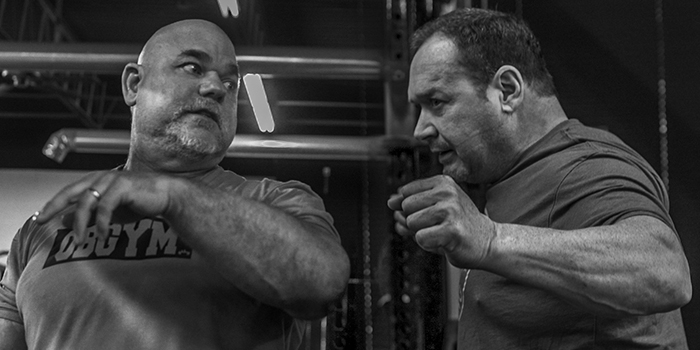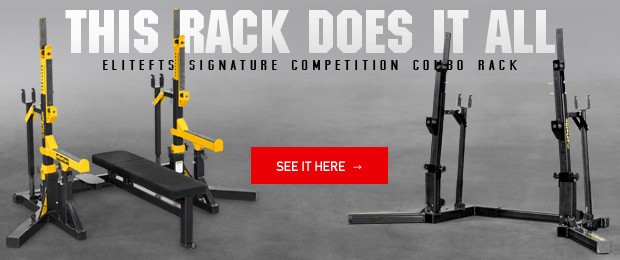
Ed Coan and Dave Tate join forces at Omaha Barbell to share their powerlifting inspiration, meet with fans, and coach groups of athletes in the squat. As Tate and Coan provide hands-on instruction and demonstrate proper squatting technique, the difference that their expertise makes in the athletes’ performance is clear and immediate.
WATCH: Ed Coan and Dave Tate on Their Powerlifting Inspiration
For Tate, there is no such thing as sugarcoating when it comes to providing honest and productive feedback to his powerlifters. He gives it to them straight, showing the tough love that is necessary to take their squats to the next level. Having known Tate for years, Coan explains:
He’s always been the same guy. He’s always been the same funny, ornery motherfucker that’s going to tell you the truth. [And] you want someone that tells you the truth. But he’s not doing it to be mean – Dave says shit because it’s a fact and he wants to help you. Sometimes people need a little tough love.
Minimizing Knee Strain
Coan begins by working with a group of athletes on perfecting their squatting stance. He encourages them to lift their chins and try to open up their groins earlier on the way down into the squat. This latter point is particularly important to Coan. As he explains, many powerlifters today are under the impression that they just have to use their legs to come out of the hole and back to the top. However, if an athlete just uses their legs during this movement, they will tip. As such, it’s important for them to drive their backs into the bar at the same time so they have equal pushes in both directions that enables them to use their hips.
Coan admits that in the past, he’s tried to focus on pushing his knees outwards, yet often felt strain associated with that movement. Instead, he explains, if he breaks his hips, it naturally prompts his upper-groin to open. If this part of the body can remain open during the movement, it causes the knees to come out, thereby minimizing the strain.
Deliberate Walk-Outs
Meanwhile, Tate addresses another group that seems to be struggling with variations of their walk-outs. He advises them to be increasingly deliberate about the movements that they take before actually executing the squat itself. It’s important to avoid adding extra movements – no turning, no coming up on the toes, just step, step, step. Whether it’s three steps or four (but never more than four), athletes must make a conscious effort to be intentional and keep their toes from coming up off of the ground.
As Tate explains, any extra movement in the walk-out causes athletes to lose precious energy. Naturally, this may not have as much bearing when lifting weights that are under 60%, but as more weight is added, the physical (and mental) difference can be quite significant. While exact walk-out technique can differ depending on the individual, Tate reiterates the importance of keeping the feet flat on the floor. As one powerlifter executes her squat using smaller, energy-conserving steps, she exclaims as to how much easier the movement becomes. Indeed, not only easier, but also more effective.
Breathing and Bracing
Tate continues with his group by focusing next on breathing. Currently, the majority of the group is relying on pulling air into their chests. However, this does not allow for optimal bracing of the body. As Tate explains, this can actually lead to improper form:
When you go to squat, and it gets hard, and you breathe out – then your chest drops, the bar goes forward, and you end up falling forward.
Instead, the key is to breathe into the belly and ensure that the torso remains tight. If wearing a belt, athletes should push into the belt from every angle to feel the breath around the core (as opposed to the chest). Tate also provides an expert tip: typically, athletes can get more air into their torsos if they breathe in first through their noses, then in through their mouths. Thus, powerlifters should position themselves under the bar, breathe deeply in through the nose into the belly, step back into their stance, and then pull a little bit of extra air in through the mouth. All of a sudden, they will feel that everything is braced, tight, and solid – ready to squat.
Proper Hand Placement
Elsewhere in the gym, Coan coaches another group on a specific, yet significant component of the squat: proper hand placement on the bar. He instructs them to avoid letting their hands come over the bar too much; instead, their hands should be positioned slightly underneath the bar. Improper hand placement causes the elbows to come up and the shoulders to point forward, thereby positioning the body too far forward for the load.
By making this small adjustment, everything locks into place from the neck down to the lower back. Not only does this protect the spine, but it also allows for a bigger squat. A stronger base prevents any weakness in the back that would potentially cause a break with heavy weight. With proper hand placement, the body can push as one piece for a stronger, safer squat.
Finding the “One Thing”
As Tate and Coan work with the athletes, it may seem like they are focusing in on details so small that they couldn’t possibly have a meaningful impact on overall technique. On the contrary, this method of precision and isolation is proven to be effective. Coan and Tate are far too seasoned to try and boil the ocean with their coaching approach. Instead, they are looking for the one thing that, if adjusted, will naturally correct everything else.
You’re looking for one thing that does like five things, and change it. We’re not trying to change five things – find the one thing that does everything at the same time.
By the Minute
- (1:30) – Minimizing Knee Strain
- (2:50) – Deliberate Walk-Outs
- (4:55) – Breathing and Bracing
- (7:15) – Proper Hand Placement










1 Comment